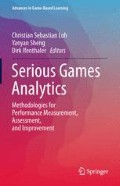Abstract
In this chapter we describe Analysis of Patterns in Time (APT) and how it can be used to analyze gameplay choices to provide evidence of a play-learner’s understanding of concepts modeled in a game. APT is an empirical approach to observing and coding phenomena as mutually exclusive and exhaustive categories within classifications. These data form a temporal map of joint and sequential patterns. We examine the case of the online Diffusion Simulation Game. An algorithm calculates scores for gameplay data patterns and compares them with scores for patterns based on optimal strategies derived from the game’s conceptual model. We discuss the results of using APT for analysis of game sessions for three play-learners. We describe how APT can be included as part of a serious game to conduct formative assessment and determine appropriate hints, coaching, or other forms of scaffolding during gameplay. We conclude by discussing APT methods for summative assessment.
Access this chapter
Tax calculation will be finalised at checkout
Purchases are for personal use only
References
Brandes, U., & Erlebach, T. (2005). Network analysis: Methodological foundations. Berlin, Germany: Springer.
Coombs, C. H., Dawes, R. M., & Tversky, A. (1970). Mathematical psychology: An elementary introduction. Englewood Cliffs, NJ: Prentice-Hall.
Frick, T. (1983). Nonmetric temporal path analysis (NTPA): An alternative to the linear models approach for verification of stochastic educational relations. Unpublished doctoral dissertation, Indiana University, Bloomington, IN. Retrieved from http://www.indiana.edu/~tedfrick/ntpa/
Frick, T. (1990). Analysis of patterns in time (APT): A method of recording and quantifying temporal relations in education. American Educational Research Journal, 27(1), 180–204.
Frick, T. (1997). Artificial tutoring systems: What computers can and can’t know. Journal of Educational Computing Research, 16(2), 107–124.
Frick, T., Kim, K.-J., Ludwig, B., & Huang, R. (2003). A Web simulation on educational change: Challenges and solutions for development. Paper presented at the meeting of the Association for Educational Communication and Technology, Anaheim, CA. Retrieved from http://www.indiana.edu/~tedfrick/aect2003/frick_kim_ludwig_huang.pdf
Frick, T., Myers, R., Thompson, K., & York, S. (2008). New ways to measure systemic change: Map & analyze patterns & structures across time (MAPSAT). Featured research paper presented at the annual conference of the Association for Educational Communications & Technology, Orlando, FL. Retrieved from https://www.indiana.edu/ ~tedfrick/MAPSATAECTOrlando2008.pdf
Jensen, F. V., & Nielsen, T. D. (2007). Bayesian networks and decision graphs (2nd ed.). New York, NY: Springer.
Maccia, E. S., & Maccia, G. (1966). Development of educational theory derived from three educational theory models (final report, project no. 5-0638). Washington, DC: U.S. Department of Health, Education, and Welfare.
Molenda, M., & Rice, J. M. (1979). Simulation review: The diffusion simulation game. Simulation and Games, 10(4), 459–467.
Myers, R. D. (2012). Analyzing interaction patterns to verify a simulation/game model. Unpublished doctoral dissertation, Indiana University, Bloomington, IN. Retrieved from http://webgrok.com/papers/RodneyMyers_DissertationFinal_Approved.pdf
Myers, R. D., & Frick, T. W. (2015). Measuring effectiveness of instructional games and simulations: Pattern analysis of play in the Diffusion Simulation Game. Bloomington, IN.
Myers, R. D., & Reigeluth, C. M. (in press). Designing games for learning. In C. M. Reigeluth, B. Beatty, & R. D. Myers (Eds.). Instructional-design theories and models (Vol. IV).
Reigeluth, C. M., & Frick, T. W. (1999). Formative research: A methodology for creating and improving design theories. In C. M. Reigeluth (Ed.), Instructional-design theories and models: A new paradigm of instructional theory (Vol. II, pp. 633–651). Mahwah, NJ: Lawrence Erlbaum.
Reigeluth, C. M., & Schwartz, E. (1989). An instructional theory for the design of computer-based simulations. Journal of Computer-Based Instruction, 16(1), 1–10.
Rogers, E. M. (1962). Diffusion of innovations. New York, NY: Free Press.
Rogers, E. M. (2003). Diffusion of innovations (5th ed.). New York: Simon & Schuster.
Scriven, M. (1967). The methodology of evaluation. In R. Tyler, R. Gagné, & M. Scriven (Eds.), Perspectives of curriculum evaluation. AERA monograph series on curriculum evaluation (pp. 39–83). Chicago, IL: Rand McNally.
Thompson, K. (2008). ATIS graph theory. Columbus, OH: System Predictive Technologies. Retrieved from http://www.indiana.edu/~aptfrick/reports/11ATISgraphtheory.pdf
Witten, I. H., Elbe, F., & Hall, M. A. (2011). Data mining: Practical machine learning tools and techniques (3rd ed.). Burlington, MA: Morgan Kaufmann.
Worthen, B., & Sanders, J. (1987). Educational evaluation: Alternative approaches and practical guidelines. New York, NY: Longman.
Author information
Authors and Affiliations
Corresponding author
Editor information
Editors and Affiliations
Rights and permissions
Copyright information
© 2015 Springer International Publishing Switzerland
About this chapter
Cite this chapter
Myers, R.D., Frick, T.W. (2015). Using Pattern Matching to Assess Gameplay. In: Loh, C., Sheng, Y., Ifenthaler, D. (eds) Serious Games Analytics. Advances in Game-Based Learning. Springer, Cham. https://doi.org/10.1007/978-3-319-05834-4_19
Download citation
DOI: https://doi.org/10.1007/978-3-319-05834-4_19
Publisher Name: Springer, Cham
Print ISBN: 978-3-319-05833-7
Online ISBN: 978-3-319-05834-4
eBook Packages: Humanities, Social Sciences and LawEducation (R0)

